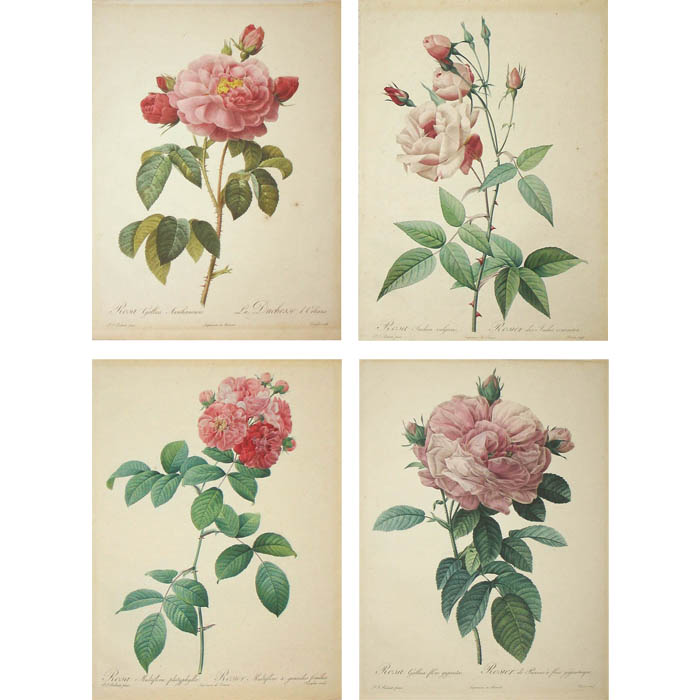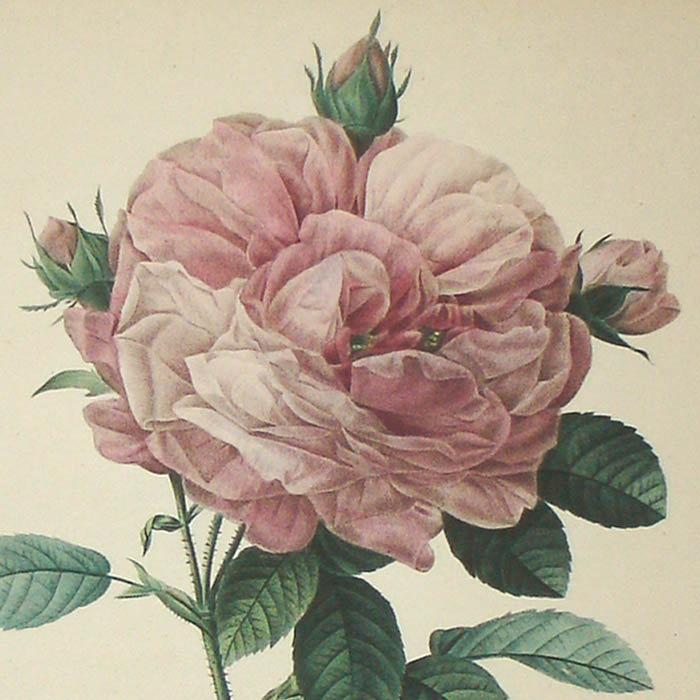Description
Pierre-Joseph Redouté is the greatest botanical artist of the golden era of French botanical illustration — the first four decades of the 19th century. His artistic career lasted an astonishing 67 years. According to botanical scholar Wilfred Blunt, “[r]oyal patronage, tireless energy, and the assistance of a brilliant team of stipple engravers and printers, made it possible for him to produce illustrated books which have few rivals in the whole history of botanical art.” Born in Belgium to a family of artists, Redouté left home at age 13, traveling, studying art, and making a living as an itinerant painter for the next 10 years, when he arrived in Paris to join his older brother, a theatrical scene painter. Following his interest in flower painting, he began to frequent the Jardin du Roi (King’s Garden). There he met his first major patron, the wealthy botanist Charles Louis L’Héritier de Brutelle, for whom he illustrated two botanical studies. He also became a protégé of the Dutch artist Gerard van Spaendonck (1746-1882), professor of flower painting at the museum at the Jardin, whose watercolor technique profoundly influenced Redouté’s style. In 1793, Redouté and his younger brother joined the museum staff; after van Spaendonck’s death in 1822, Redouté succeeded him as a “master of drawing.”
In 1798, Redouté attracted another important patron, the Empress Josephine, wife of Napoleon Bonaparte, who commissioned an extensive series of paintings after the ornamental flowers in her lavish gardens at Malmaison, which became the plates for the books Jardin de Malmaison (1803-04), Description des Plantes Rares Cultivées à Malmaison et à Navarre (1813). He also created plates for Duhamel du Monceau’s monumental seven-volume horticultural study on fruit trees, Nouveau Traité des Arbres Fruitiers (1800-19). During this period he also produced two of his most famous works: Les Liliacées (1802-16) and Les Roses (1817-24). There followed another renowned collection, Choix Des Plus Belles Fleurs (1827-33). Redouté was esteemed by his artistic peers, and influenced a number of younger botanical artists including Pierre Jean François Turpin, Pierre-Antoine Poiteau, Pancrace Bessa, Mme. Vincent and Jean Prévost. In 1825, he was made a member of the Legion of Honor.
A large number of Redouté’s original watercolors on vellum are in the collection of the Musée National de La Malmaison in France and other museums, though many are in private collections. His renown, however, is due to the remarkable quality of the prints made after these paintings, which brought his works to a wider audience during his lifetime and thereafter. The most accomplished engravers of the period were engaged to translate his original paintings into stipple engravings, in which the plates are etched with small dots rather than lines. Indeed, Redouté helped refine the stipple engraving process to best capture the subtle effects, luminosity, sheen and dimensionality of his original paintings. Through a method he invented in 1796, the colors were applied to the engraved plate a la poupée before each printing, “giving to our prints all the softness and brilliance of a watercolor,” as Redouté noted. Finally, each print was finished with additional coloring by hand. Redouté’s high standards are evident in the striking way in which the resulting prints capture the subtle delicacy of flower petals and foliage.
Redouté’s Les Roses is arguably the most beloved botanical book ever published. During the period in which it was produced, Redouté was at work on a series of paintings commissioned by Empress Josephine Bonaparte her gardens. Though these rose paintings were not part of that commission, the work was facilitated by Redouté’s access to the fine specimens in her garden.
Condition: Generally fine, with only minor toning and wear. Faint, minor, very light scattered spotting. Disbound string marks far left margin. Some plate marks trimmed, some printed on slight angle, as is generally the case with Les Roses. Overall wonderful examples, with rich original color that effectively captures the watercolor effect that Redouté sought, making these exemplary botanical prints.
References:
Blunt, Wilfred, rev. by Stearn, William T. The Art of Botanical Illustration. Woodbridge, Suffolk, England: Antique Collectors Club, 1994. pp. 25-26, 194-209.
Brindle, John V., James J. White and Donald E Wendel. Flora Portrayed: Classics of Botanical Art from the Hunt Institute Collection. Pittsburgh, PA: Hunt Institute for Botanical Documentation, Carnegie-Mellon University, 1985. pp. 44-45.
Dunthorne, Gordon. Flower and Fruit Prints of the 18th and Early 19th Centuries. Their History, Makers and Uses, with a Catalogue Raisonne of the Works in Which They are Found. Washington, D.C.: Published by the Author, 1938. 231 (Redouté Lilies), 232 (Redouté Roses), 235 (Redouté Choix).
Filiberti, Daphne. “The China Roses.” RoseGathering.com. 2000. http://www.rosegathering.com/china.html (10 December 2004).
Lawrence, G.M.A., F.A. Stafleu, I. MacPhail, J.V. Brindle and A. Lawalrée.
A Catalogue of Redoutéana. April-Aug. 1963. Pittsburgh, PA: Carnegie Institute of Technology, Hunt Botanical Library, 1963. 10 (Redouté Lilies), 19 (Redouté Roses), 20 (Redouté Choix).
“Magnificent Plate Books from the Library of the Earl of Bradford: Lot 67.” Sotheby’s. 15 March 2000. http://search.sothebys.com/jsps/live/lot/LotDetail.jsp?lot_id=V7QT (24 March 2006).
Nissen, Claus. Die Botanische Buchillustration: ihre Geschichte und Bibliographie. Stuttgart:1951-66. 1591 (Redouté Choix), 1597 (Redouté Lilies), 1599 (Redouté Roses).
Pritzel, Georg August. Thesaurus Literaturae Botanicae Omnium Gentium. Milan: 1950. 7456 (Redouté Choix).
Sitwell, Sacheverell. Great Flower Books, 1700-1900. New York: The Atlantic Monthly Press, 1990. pp. 71-72.
Stafleu, Frans A. and Richard S.Cowan. Taxonomic Literature. Utrecht: 1967. 2nd ed., Utrecht: 1976-1988. TL2 8747 (Redouté Lilies), TL2 8748 (Redouté Roses), TL2 8750 (Redouté Choix).













